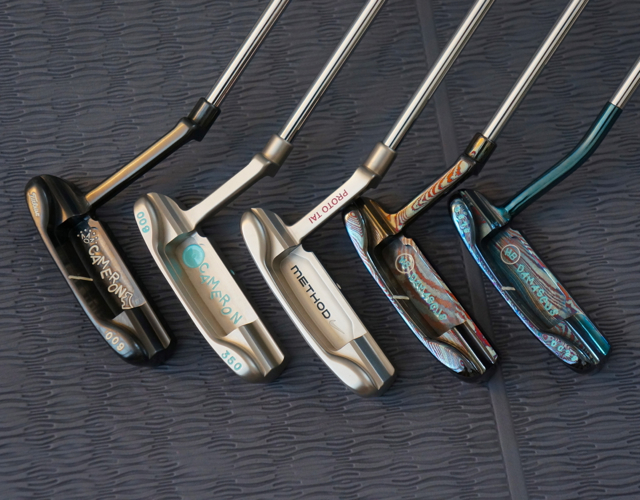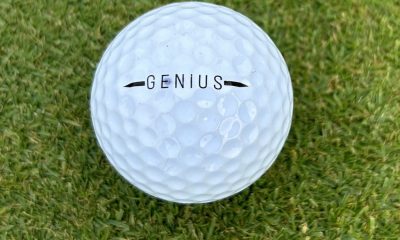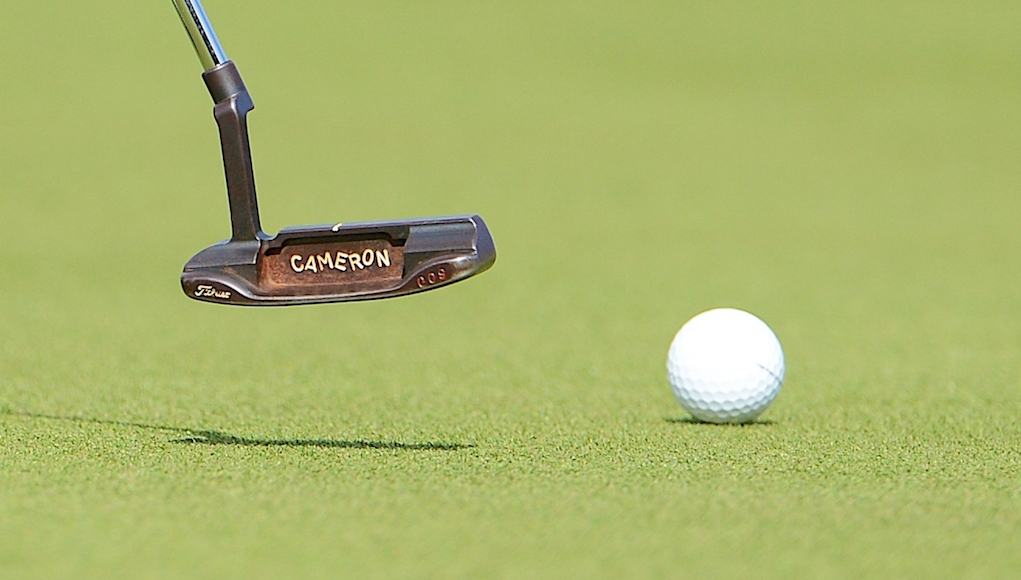Instruction
The Ultimate Putting Program (Part 3): Pick a putter that matches your path

We have discussed how the design of a putter affects a golfer’s ability to control aim and speed. Now it is time to look at how it affects the path of the stroke.
I believe the optimal path of a putting stroke is one that returns the putter head to impact so that it’s perpendicular to the target line. This seems to provide the most room for error. Others may believe that it is ok to have variations within the path and aim so long as the two cancel each other out and the ball rolls toward the target. Whichever way you look at it, there are design elements of the putter that influence face rotation, thus affecting the direction of the putter at impact.
On almost every putting green, I’ve seen golfers trying to become better putters. But many of them try to improve the path of their stroke before addressing their ability to aim their putter at address. Someone can work on the path of their stroke all they want, but I’ve found that if they don’t aim their putter at the target, it will be difficult to improve.
If you have not already read The Ultimate Putting Program (Part 1): The Design of Your Putter Influences Aim, click here to do so. It will give you the framework to understand my take on path.
Let’s consider a golfer who consistently miss-aims his putter 4 inches left of the hole, and has developed a compensating action during his stroke to roll the ball on his intended line. The compensation may be a push stroke, an opening of the clubface or a combination of the two. This type of compensation may work fine, but is likely to be inconsistent in the long run. It is also very likely that after a bad round of putting, a friend, or maybe the local golf professional will mention that he has an in-to-out stroke, and for him to become a better putter he will need to improve the path of his stroke.
So what happens? The golfer likely sees this as great information, and begins working on improving his path. He may even go as far as to practice the various putting drills that are so commonly recommend. Well, guess what? It is very likely that the will indeed improve the path of his stroke, but unfortunately for him, he won’t be aiming at the target, so now he will simply roll the ball where he is aiming; four inches left of the hole.
That’s why I suggest first improving aim, and then developing a stroke path that rolls your ball on your intended line. In my opinion, this is the easiest route for most golfers to improve.
Path Type: Arc or Straight-Back-Straight-Through (SBST)

There is a continuing debate amongst golfers on whether an arcing stroke or a SBST stroke is correct. I imagine that neither stroke is any better or worse than the other, but the fact of the matter is that a true SBST stroke is a manipulation of the hands and the wrists, whereas the arcing stroke adheres more to the laws of geometry and physics.
The amount of arc in a golfer’s stroke is primarily the result of how far the golfer stands from the ball. A golfer who stands rather close to the ball is likely to have a stroke that is close to being SBST, whereas someone who stands farther from the ball will likely have more of an arcing stroke. A golfer’s spine angle at address also is a contributing factor to the amount of arc in their stroke. A golfer who stands upright is likely to create more of an arc than someone who bends over more. I believe these are preferences for each golfer, though it is important to match a putter with a golfer’s path type.
Putter design affects path, which affects aim at impact
It is important to match the rotational aspect of the putter with a golfer’s stroke to allow the putter face to be square to the target at impact. The traditional way to test a putter for rotational value is to balance the shaft of a putter on your finger and notice how the club head hangs. The picture below shows putters with varying amounts of toe hang.
It is even more revealing when you do this on the inclined plane of the putting stroke to see gravity’s affect on the putter during the stroke. It may be an eye opener for some golfers to know that most putters are designed to “open” during the stroke, making it difficult to return the putter square to the target at impact. Putters can have various degrees of toe hang, and they can also be “face-balanced” and even “heel-balanced.”
As a general rule of thumb, it is a good idea for players with very little arc in their stroke to use a face- or heel-balanced putter. Players who have more arc in their stroke generally prefer a putter with some degree of toe hang, as they like the sensation of the putter face “releasing” through impact. I have been experimenting with a heel-balanced putter and I am noticing that it offers a very solid strike through impact (I would say that my natural stroke is one with medium amount of face rotation).
The weight of the putter head also affects the amount of face rotation. Heavier putter heads rotate slower than lighter ones. The amount of rotation that a golfer seeks will dictate where and how much weight should be added to the putter. By counter weighting or adding weight internally through a the puter shaft, a golfer can increase the overall weight of the putter without affecting its rotation.
Drills to Improve the Path of Your Stroke
1. The first drill is to develop a target line from the ball to the hole, which can be done in two different ways (more on that below).
The goal of this drill is to produce a path that rolls the ball on the intended line. For an arc stroke, it will allow you to see your putter move slightly inside the target line on the backstroke, square to the target line at impact, and slightly inside the target line on the forward stroke. For a SBST stroke, it will allow you to see the putter head stay on the target line throughout the stroke.
Using a chalk line is a good way to learn to roll the ball on the intended line. Another good drill for golfers who keep their eyes over the ball is to tie a knitting needle to both sides of a 10-foot string. Then find a straight putt, and place the needles in the ground so that one of them is slightly behind the hole, and the other is far enough to make the string taught. The string should be directly over the target line with enough room to putt towards the hole, while keeping the putter beneath the string. For players who stand far enough from the ball for their eyeline to be inside the target line (not over the ball) using a chalk line will be more beneficial since the string requires a golfer’s eyes to be over the ball.
Editor’s Note: If you decide to use the chalk line drill, do your best to choose an area of the practice green where you are not impeding the practice of others. Also, be weary of “wearing out” a spot on the green with your foot marks. Green keepers and follow golfers with thank you.
Either of these methods can also be done on breaking putts. Just set the target line on a tangent of the intended path of the ball so that the ball will break to the hole. You may be surprised of how much break is required for the ball to go in the hole with optimal speed (6-to-8 inches past the hole on a miss). I will explain more on green reading in my next article.
2. The next drill is to place a tee on either side of the putter head and roll putts so that the putter head swings between the two tees. The goal of this drill, which is called the “gate drill,” is to learn to contact the golf ball with the center of the putter face. Then setup two more tees slightly wider than the golf ball on the target line. The objective is to roll the ball between the tees, which if done correctly will produce a putter face that is square to the target at impact. This drill offers immediate feedback since the ball will hit the tees if done improperly.
I like to use both the chalk line and gate drills in combination of one another for an even better practice session.
By now, you should have a better understanding of the key variables that are essential for you to improve your putting; Aim, Speed, and Path. In my next article, I will discuss two ways of reading greens to help you put all of this information into action and become a better golfer.
To Continue With The Ultimate Putting Program:
Instruction
The Wedge Guy: Beating the yips into submission

There may be no more painful affliction in golf than the “yips” – those uncontrollable and maddening little nervous twitches that prevent you from making a decent stroke on short putts. If you’ve never had them, consider yourself very fortunate (or possibly just very young). But I can assure you that when your most treacherous and feared golf shot is not the 195 yard approach over water with a quartering headwind…not the extra tight fairway with water left and sand right…not the soft bunker shot to a downhill pin with water on the other side…No, when your most feared shot is the remaining 2- 4-foot putt after hitting a great approach, recovery or lag putt, it makes the game almost painful.
And I’ve been fighting the yips (again) for a while now. It’s a recurring nightmare that has haunted me most of my adult life. I even had the yips when I was in my 20s, but I’ve beat them into submission off and on most of my adult life. But just recently, that nasty virus came to life once again. My lag putting has been very good, but when I get over one of those “you should make this” length putts, the entire nervous system seems to go haywire. I make great practice strokes, and then the most pitiful short-stroke or jab at the ball you can imagine. Sheesh.
But I’m a traditionalist, and do not look toward the long putter, belly putter, cross-hand, claw or other variation as the solution. My approach is to beat those damn yips into submission some other way. Here’s what I’m doing that is working pretty well, and I offer it to all of you who might have a similar affliction on the greens.
When you are over a short putt, forget the practice strokes…you want your natural eye-hand coordination to be unhindered by mechanics. Address your putt and take a good look at the hole, and back to the putter to ensure good alignment. Lighten your right hand grip on the putter and make sure that only the fingertips are in contact with the grip, to prevent you from getting to tight.
Then, take a long, long look at the hole to fill your entire mind and senses with the target. When you bring your head/eyes back to the ball, try to make a smooth, immediate move right into your backstroke — not even a second pause — and then let your hands and putter track right back together right back to where you were looking — the HOLE! Seeing the putter make contact with the ball, preferably even the forward edge of the ball – the side near the hole.
For me, this is working, but I am asking all of you to chime in with your own “home remedies” for the most aggravating and senseless of all golf maladies. It never hurts to have more to fall back on!
Instruction
Looking for a good golf instructor? Use this checklist

Over the last couple of decades, golf has become much more science-based. We measure swing speed, smash factor, angle of attack, strokes gained, and many other metrics that can really help golfers improve. But I often wonder if the advancement of golf’s “hard” sciences comes at the expense of the “soft” sciences.
Take, for example, golf instruction. Good golf instruction requires understanding swing mechanics and ball flight. But let’s take that as a given for PGA instructors. The other factors that make an instructor effective can be evaluated by social science, rather than launch monitors.
If you are a recreational golfer looking for a golf instructor, here are my top three points to consider.
1. Cultural mindset
What is “cultural mindset? To social scientists, it means whether a culture of genius or a culture of learning exists. In a golf instruction context, that may mean whether the teacher communicates a message that golf ability is something innate (you either have it or you don’t), or whether golf ability is something that can be learned. You want the latter!
It may sound obvious to suggest that you find a golf instructor who thinks you can improve, but my research suggests that it isn’t a given. In a large sample study of golf instructors, I found that when it came to recreational golfers, there was a wide range of belief systems. Some instructors strongly believed recreational golfers could improve through lessons. while others strongly believed they could not. And those beliefs manifested in the instructor’s feedback given to a student and the culture created for players.
2. Coping and self-modeling can beat role-modeling
Swing analysis technology is often preloaded with swings of PGA and LPGA Tour players. The swings of elite players are intended to be used for comparative purposes with golfers taking lessons. What social science tells us is that for novice and non-expert golfers, comparing swings to tour professionals can have the opposite effect of that intended. If you fit into the novice or non-expert category of golfer, you will learn more and be more motivated to change if you see yourself making a ‘better’ swing (self-modeling) or seeing your swing compared to a similar other (a coping model). Stay away from instructors who want to compare your swing with that of a tour player.
3. Learning theory basics
It is not a sexy selling point, but learning is a process, and that process is incremental – particularly for recreational adult players. Social science helps us understand this element of golf instruction. A good instructor will take learning slowly. He or she will give you just about enough information that challenges you, but is still manageable. The artful instructor will take time to decide what that one or two learning points are before jumping in to make full-scale swing changes. If the instructor moves too fast, you will probably leave the lesson with an arm’s length of swing thoughts and not really know which to focus on.
As an instructor, I develop a priority list of changes I want to make in a player’s technique. We then patiently and gradually work through that list. Beware of instructors who give you more than you can chew.
So if you are in the market for golf instruction, I encourage you to look beyond the X’s and O’s to find the right match!
Instruction
What Lottie Woad’s stunning debut win teaches every golfer

Most pros take months, even years, to win their first tournament. Lottie Woad needed exactly four days.
The 21-year-old from Surrey shot 21-under 267 at Dundonald Links to win the ISPS Handa Women’s Scottish Open by three shots — in her very first event as a professional. She’s only the third player in LPGA history to accomplish this feat, joining Rose Zhang (2023) and Beverly Hanson (1951).
But here’s what caught my attention as a coach: Woad didn’t win through miraculous putting or bombing 300-yard drives. She won through relentless precision and unshakeable composure. After watching her performance unfold, I’m convinced every golfer — from weekend warriors to scratch players — can steal pages from her playbook.
Precision Beats Power (And It’s Not Even Close)
Forget the driving contests. Woad proved that finding greens matters more than finding distance.
What Woad did:
• Hit it straight, hit it solid, give yourself chances
• Aimed for the fat parts of greens instead of chasing pins
• Let her putting do the talking after hitting safe targets
• As she said, “Everyone was chasing me today, and managed to maintain the lead and played really nicely down the stretch and hit a lot of good shots”
Why most golfers mess this up:
• They see a pin tucked behind a bunker and grab one more club to “go right at it”
• Distance becomes more important than accuracy
• They try to be heroic instead of smart
ACTION ITEM: For your next 10 rounds, aim for the center of every green regardless of pin position. Track your greens in regulation and watch your scores drop before your swing changes.
The Putter That Stayed Cool Under Fire
Woad started the final round two shots clear and immediately applied pressure with birdies at the 2nd and 3rd holes. When South Korea’s Hyo Joo Kim mounted a charge and reached 20-under with a birdie at the 14th, Woad didn’t panic.
How she responded to pressure:
• Fired back with consecutive birdies at the 13th and 14th
• Watched Kim stumble with back-to-back bogeys
• Capped it with her fifth birdie of the day at the par-5 18th
• Stayed patient when others pressed, pressed when others cracked
What amateurs do wrong:
• Get conservative when they should be aggressive
• Try to force magic when steady play would win
• Panic when someone else makes a move
ACTION ITEM: Practice your 3-6 foot putts for 15 minutes after every range session. Woad’s putting wasn’t spectacular—it was reliable. Make the putts you should make.
Course Management 101: Play Your Game, Not the Course’s Game
Woad admitted she couldn’t see many scoreboards during the final round, but it didn’t matter. She stuck to her game plan regardless of what others were doing.
Her mental approach:
• Focused on her process, not the competition
• Drew on past pressure situations (Augusta National Women’s Amateur win)
• As she said, “That was the biggest tournament I played in at the time and was kind of my big win. So definitely felt the pressure of it more there, and I felt like all those experiences helped me with this”
Her physical execution:
• 270-yard drives (nothing flashy)
• Methodical iron play
• Steady putting
• Everything effective, nothing spectacular
ACTION ITEM: Create a yardage book for your home course. Know your distances to every pin, every hazard, every landing area. Stick to your plan no matter what your playing partners are doing.
Mental Toughness Isn’t Born, It’s Built
The most impressive part of Woad’s win? She genuinely didn’t expect it: “I definitely wasn’t expecting to win my first event as a pro, but I knew I was playing well, and I was hoping to contend.”
Her winning mindset:
• Didn’t put winning pressure on herself
• Focused on playing well and contending
• Made winning a byproduct of a good process
• Built confidence through recent experiences:
- Won the Women’s Irish Open as an amateur
- Missed a playoff by one shot at the Evian Championship
- Each experience prepared her for the next
What this means for you:
• Stop trying to shoot career rounds every time you tee up
• Focus on executing your pre-shot routine
• Commit to every shot
• Stay present in the moment
ACTION ITEM: Before each round, set process goals instead of score goals. Example: “I will take three practice swings before every shot” or “I will pick a specific target for every shot.” Let your score be the result, not the focus.
The Real Lesson
Woad collected $300,000 for her first professional victory, but the real prize was proving that fundamentals still work at golf’s highest level. She didn’t reinvent the game — she simply executed the basics better than everyone else that week.
The fundamentals that won:
• Hit more fairways
• Find more greens
• Make the putts you should make
• Stay patient under pressure
That’s something every golfer can do, regardless of handicap. Lottie Woad just showed us it’s still the winning formula.
FINAL ACTION ITEM: Pick one of the four action items above and commit to it for the next month. Master one fundamental before moving to the next. That’s how champions are built.
PGA Professional Brendon Elliott is an award-winning coach and golf writer. You can check out his writing work and learn more about him by visiting BEAGOLFER.golf and OneMoreRollGolf.com. Also, check out “The Starter” on RG.org each Monday.
Editor’s note: Brendon shares his nearly 30 years of experience in the game with GolfWRX readers through his ongoing tip series. He looks forward to providing valuable insights and advice to help golfers improve their game. Stay tuned for more Tips!




























Bruce Rearick
Dec 25, 2013 at 9:25 am
What happens when the shape/design you aim best doesn’t match your stroke path?
Henry Stetina
Dec 28, 2013 at 10:56 am
Bruce, It is great to hear from you. Good question. I believe this is the key balancing act in being a fitter. Rotational requirements of a putter has a great deal to do with hosel configuration, weight distribution, length and lie. That being said, I like to get an understanding of a person’s intended stroke type and then watch their stroke to see if what they are producing matches their intention. For example, if a person wants a SBST style of stroke and can benefit from a “face-balanced,” I first look into a hosel that produces a “face-balanced” putter. Then I can change head shape, sight lines, length, and lie to find something that they aim correctly. Then it is all about weight for speed control and how it affects face rotation. I constantly watch how a person controls all three variables, aim, path, and speed to make the adjustments necessary.
Does this answer your question? What are you thoughts?
Bruce Rearick
Dec 30, 2013 at 8:39 pm
I think it is best to learn to aim what swings in balance with your stroke.
Davis
Dec 24, 2013 at 12:44 pm
“the fact of the matter is that a true SBST stroke is a manipulation of the hands and the wrists, whereas the arcing stroke adheres more to the laws of geometry and physics.”
This is untrue.
The arc of someones stroke is a product of where his hands are in relationship to his shoulders. If a person’s hands are directly under his shoulders then his stroke will be SBST. The further in front of the shoulders the person’s hands are, the greater the arc is (assuming that you are making a shoulders only putting stroke).
Matt
Dec 25, 2013 at 2:08 am
I think the article is correct. If you look it up, I’m sure you’ll find better explanations than what I’d give. But with the angle of the spine, arms, and lie, it is not possible to have a true sbst stroke without a lot of moving parts (hands, forearms).
That being said, I consider myself sbst because it’s close enough.
J C
Dec 25, 2013 at 3:55 am
what you think is sbst most of the time really follows the shaft lie plane. only way to be truely sbst is to have a 90 degree lie and move rotating joints along the vertical plane. and that causes a different problem. the club head will bottom out at the ball adn will be either decending or ascending if you falter in any other aspect of your swing, causing you to push the ball down into the green or hit up on it. im not sure if either is better i havent had the opportunity to see one of those nice putter fitting machines or know the logistics behind the best roll of the ball.
J C
Dec 25, 2013 at 3:56 am
im tired looks like a 12 yr old wrote that sorry.
Davis
Dec 26, 2013 at 10:17 am
If you haven’t, go check out David Pelz’s putting book. Not a crazy huge Pelz fan but his work on his first book is incredible. He uses his scientific approach from his time at NASA and really proves the SBST stroke.
Henry Stetina
Dec 28, 2013 at 11:41 am
Davis,
Take a look at this diagram. In both images the hands hang directly beneath the shoulders and yet it seems impossible to swing the putter SBST without manipulation of the hands. If I am wrong, will you please expand on your comment?
https://scontent-b-dfw.xx.fbcdn.net/hphotos-ash4/1480661_10151971554977530_967009183_n.png
Steve
Feb 2, 2014 at 8:14 pm
SAM Putt Lab designer did a study using Neuroscientists and found that the SBST type stroke indeed increased the use of the muscles in the lower arms during the takeaway. You have to remember that people putt on a tilted axis which is the neck and consequently the stroke will move around that axis creating natural rotation.
Dave Pelz has been an SBST proponent and when faced with this study at a PGA conference in Germany, he was baffled by the results of this study that basically disproved the SBST stroke he had been teaching.
In order to have a true SBST the lie angle of the putter would need to be 90 degees to be able to make an SBST stroke.
Great article Matt.
Kemptx
Jun 16, 2014 at 9:22 pm
Some years ago I attended a Pelz short game school. While talking about the putting stroke, one of the instructors admitted that all putting strokes have a certain degree of arc in them. I don’t know if he meant to say that as it was in opposition to what they had been teaching during the school.
Andrew
Dec 23, 2013 at 6:25 pm
I had some putting lessons earlier this year. All my problems game from aiming too far left and having a putter that didn’t suit my stroke and aim (SC Del Mar)
Moved to a center shaft SC Newport and read/aim using my dominant eye and my putting has improved massively.
Currently averaging 28 putts a round!
Really interesting set of articles Henry…putting is 40% of the game and it’s easy for most to see an improvement with a few lessons and a bit of practice!
Jadon
Dec 26, 2013 at 8:56 am
Does that mean you have a SC Del Mar you’re wanting to put in the garbage???? Let me take it off your hands.
Henry Stetina
Dec 28, 2013 at 11:44 am
Andrew, thank you for your feedback. Sounds as though you have already found a benefit from learning about putter design. Great to hear!